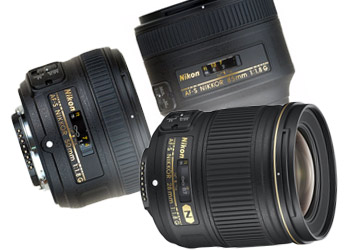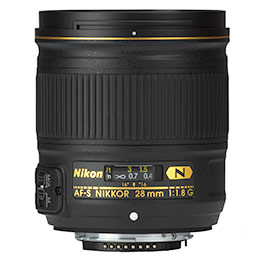Last Updated: Aril 26, 2012 | By Brian Tobey Email Google+
NIKON 1.8G PRIME LINEUP
SUMMARY

INTRODUCTION
With the most recent Nikon 28mm f/1.8G announcement, Nikonís inexpensive FX primes are quite appetizing. Within the past year, Nikon has updated their FX 1.8 lineup with the 28mm f/1.8G, 50mm f/1.8G, and the 85mm f/1.8G. And they all cost a quarter of the price of the f/1.4s. This is great news for those of you who have held off on the expensive 1.4G glass.
So how do these lenses compare to their 1.4 counterparts? Well I have spent some time looking into this and would like to share some of my findings. Of course the 28mm is too new for a comparison, but I do have some experience with the 24mm f/1.4G. I will be updating this page when I receive my 28mm f/1.8G.
THE 1.4 LENSES
Throughout 2010, Nikon released replacements for the old film, ďversion DĒ, prime f/1.4 lenses. The 28mm f/1.4D and 85mm f/1.4D was updated with a new AF-S autofocus motor and improved glass coatings, with minor optical design changes. The new 24mm f/1.4G and the new 85mm f/1.4G offer incredible optics with modern build designs, but come at a tremendous cost of $2199 and $1699 respectively. Although this is great for your full time professional, it is out of reach for many, as the price is just too high to justify the means.
THE 1.8 LENSES
However, in the summer of 2011, this all changed with the introduction of the new 50mm f/1.8G. And later in early 2012, Nikon released the 85mm f/1.8G followed by the 28mm f/1.8G 4 months later. This new 1.8 lineup comes at a much lesser cost at $219, $499, and $699, and judging from my experience with the first two, this lineup exceeds my expectations for this price range. Both the 50mm f/1.8G and 85mm f/1.8G are incredible sharp and provide nice quality background blur that produce pleasing portraits. The 28mm f/1.8G opens up more opportunity for low light wide angle use, great for street photography, group photos and event photography. Not to mention, any of these can be used in landscapes for incredible sharp results.
NEW 1.8G LENSES
NIKON 50MM 1.8 G

The Nikon 50mm f/1.8G is just simply amazing for the price. Although it adds some slight barrel distortion (easy correctable) from its predecessor the 50mm f/1.8D, it produces much more pleasing background blur when shot at shallow depth of fields. It is extremely light, and offers manual focus override. Flare is not an issue and nano crystal coating is not needed. Itís autofocus is adequate and not any more fast than the f/1.4G that costs twice as much. I would recommend this lens to nearly anyone.
NIKON 85MM 1.8 G

The Nikon 85mm f/1.8G surpasses the old 1.8D. The 1.8D had horrific background blur qualities that completely distracted any subject. Although it was extremely sharp, this new 85mm f/1.8G is even sharper. Further the old 1.8D had clumsy mechanics. This new model has manual focus override, simply grab the ring at anytime to manually focus.
Compared to the 85mm f/1.4G, that costs more than 3 times the amount, it holds its own. The 85mm f/1.4G is built better, with better weather sealing. Further, the f/1.4G has superior background blur quality. The autofocus of the f/1.4G is a bit faster, although both are slow for my taste. Overall the 85mm f/1.8G presents a better value, with nearly the same great optics of the f/1.4G.
NIKON 28MM 1.8 G

The newest of the bunch is the 28mm f/1.8G, a wide angle prime. This is my personal favorite. It is on par with the 24mm f/1.4G and costs one third the cost. The autofocus is not as snappy as the 2.8 zooms, but it is no worse than the 24mm. It can be used professionally. However it has a bit more plastic than the 24mm 1.4G and is not as environmentally sealed. And unlike the 24mm itís made in China.
The optical performance is surprisingly great. There is some vignetting wide open, but this is expected. It has some minimal barrel distortion, but is well contained. The bokeh is somewhat poor, but better than any zoom at this focal length.
Note that some individuals have reported autofocus issues. I have not encountered any autofocus problems on the D700, D800, or D4.
Shooting wide angle with large apertures is wild. First off motion blur is not as detectable with a wide angle. Then you add it the light capturing ability of an f/1.8 or f/1.4 and you are blown away. I love my 24mm f/1.4G for this reason.
It also provides a uniqueness with its somewhat shallow depth of field and wide perspective. This is unusual because depth of field is determined by both aperture, focal length, and distance to the subject. Wide angle lenses provide much greater depth of field, but the f/1.8 or f/1.4 apertures counteract this, causing backgrounds to blur out.
NEED FOR AN F/1.4 LENS
After reading this you may question the need to step up to an f/1.4 lens, as the f/1.4 lenses do not provide much more light gathering capability (2/3 stop). However, what they do provide is a bit higher quality optics, primarily in areas of background blur. Although it is subtle, it remains distinguishable enough for most professionals to jump up to the f/1.4 lenses. Additionally, the f/1.4 lenses are better environmentally sealed and built to a higher standard. They are more reliable, which is something a professional depends on. For those of you who are only seasonal pros, I would recommend the f/1.8 lenses instead. All of these recent 1.8 releases are superb.
1.8G LINEUP VIDEO DISCUSSION
D800 AND D600?
RESOLUTION QUALITY
Absolutely these lenses are D800 certified! All these lenses are plenty sharp to render highly detailed images on the D800 and D3200 (high pixel density). I suspect together with a D800, you will be able to render images above 80 lp/mm when shot at f/5.6! Yes these lenses are impressive. These lenses are also perfect companions for the upcoming D600, which is slated to be an entry level full frame FX DSLR. The ">D600 is expected to be priced at $1999, which these lenses will compliment quite well.
CONCLUSION
PHOTOGRAPHERS OPINIONS
Some may ask why Nikon is releasing these f/1.8 primes when it has other holes in its lineup. I understand there are some holes in Nikons lineup, especially in CX and DX lenses, but I think these prime lenses are important, especially with the possibility of a new D600 FX camera, which is expected to be more affordable than the D700! Additionally, other primes (the 1.4s) are out of reach for most in terms of pricing, and prime lenses have always outperformed zooms. I am excited for these new primes. My opinion is limited, as I prefer to shoot events and people. Others who shoot wildlife, nature and landscapes may feel otherwise.
RELATED ARTICLES
Nikon 50mm 1.8G Review | Nikon 85mm 1.8G Review | Nikon 28mm 1.8G Review